Inside: 100 Great Children’s Books is the selection of the best-written, most inspiring, beautiful, and entertaining picture books you might not know about.
If you’ve read Where the Wild Things Are, Amelia Bedelia, and other classic picture books with your children and wonder if there are lesser-known books that are no less amazing, you are right! There are one million new books published in the US alone every year, and the chance of every brilliant book making it to your bookshelves (or even to your library) is pretty slim.
That’s where I can help. We read hundreds and hundreds of books each year and share them with you. I love to write about our fantastic discoveries in our monthly book lists and themed compilations on my blog, but after some thought, I’ve decided that the best of the best books deserve their own post.

In case you haven’t heard this before, let me tell you about our reading habits. We read aloud for about an hour every day. It’s been our family thing for over a decade. My older two kids are proficient enough readers to read any books of their interest on their own (which they do a lot), but we still read books together, too. Why? Because we love it, of course! Plus, their comments and our book discussions are the best mirrors to the workings of their minds. And who doesn’t want to understand their kids better?
Not counting thousands of books we own, we now have six library cards, which means at any given point in time we have 300 books checked out from the library.
We go to the library every week with giant bags full of returns and come home with giant bags full of new treasures to peruse. Some books are immediate returns, others are sort of okay (we can even extend them a few times), and then there are the ones we extend and extend, or end up buying (best of the best).
So if you’re looking for a new book to read with your children, check out this ultimate list I put together for you. For ease of navigation, I’ve divided the books into seven categories:
- Destined to be a classic (or Best of the best)
- Great books with great lessons
- Mind-expanding books we love
- Picture book biographies
- Books that make us laugh (a lot)
- Books with best illustrations
- Poetry
Happy Reading!
P.S. There might be way more than 100 books on this list; I kept losing count after seventy 😉
P.P.S. Disclosure: This post contains Amazon affiliate links that provide me with a small commission if purchases are made.
Destined to be a Classic or The Best of the Best

The Wall in the Middle of the Book, Jon Agee
This book is ridiculously awesome, and it’s not just for kids. As soon as we are old enough to understand heartache, we start building walls around ourselves because this is how we protect our hearts. We start excluding people who are different, avoid activities that might show us in a bad light, and stop readily taking chances. And maybe self-imposed walls do keep us safer, but they also stop us from seeing that there is a whole world on the other side of the wall. So climb over your wall and meet positive people and wonderful things that you locked out in the name of security.
The book offers lots of terrific discussion points, and Agee’s double-page spreads are masterfully expressive. It’s a wonderful addition to any library.

Hello, Lighthouse, Sophie Blackall
We are in love with Hello, Lighthouse. My ten-year-old carried this book around with him for days, showing it to everyone who visited us with the words “Have you read it?! It’s the best!” It skillfully weaves one family’s story into a timeless classic about the passage of time, change of seasons, and technological advancement.
The author’s gorgeous artwork is done in Chinese ink and watercolor on hot-press paper. And I’m happy to say it won the 2019 Caldecott Medal for its illustrations. My kids’ favorite page depicts a wild tumble of giant waves crashing against the lighthouse during a big storm. Definitely check out this book!

How to Be a Lion, Ed Vere
How to Be a Lion is a beautiful story about a lion with a poetic flair, who chooses to become friends with a duck instead of eating it. This doesn’t go well with the other lions because that’s not what lions are supposed to do. The book explores the ideas of courage to be true to oneself, the strength of spirit, self-awareness, friendship, creativity, thinking for yourself, and so much more.
The dramatic, predominantly three-colored drawings are a pleasure to look at. The plot is thick, and the message is what we all need to hear: “Let nobody say just one way is true. There are so many ways that you can be you.”

Imogene’s Antlers, David Small
This is one of those books that each time you open it, you just can’t help smiling. Imogene is an adorable young girl that wakes up with a pair of antlers on her head. Imogene doesn’t mind in the least, but her mom is determined to make them go away to hilarious effect.
I love David Small’s heartwarming writing and expressive artwork (read his shocking autobiography Stitches). And I also love how he uses humor as a way to open a conversation about accepting things we can’t control and accepting people who are different from us. Funny and touching, this book is a gem and will prompt many rereadings in your house.
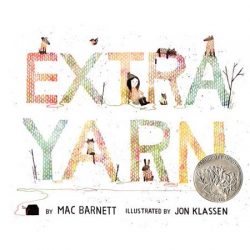
Extra Yarn, Mac Barnett
The delightful heroine of this story finds a box of magical yarn. No matter how much she knits, she never runs out. After she has knitted sweaters for every person and animal in town, she knits sweaters for buildings, cars, and trees. One day an evil archduke comes to town. It may seem that all is lost, but it isn’t. We love the unexpected ending.
Jon Klassen, the talented illustrator of multiple bestsellers and Caldecott Medalist, put his signature touch on the story. The sweet illustrations are funny and expressive and transform a good story into one that is simply irresistible.

Creepy Carrots, Aaron Reynolds
This wonderfully creepy story is just perfect. Jasper loves fat and crisp carrots that grow on Crackenhopper field near his house, but do the carrots like him? There’s lots of action, suspense, and an unexpected twist at the end.
My kids find the idea that carrots can be evil and dangerous extremely funny. This is a great book to discuss what is being said with the illustrations. Peter Brown’s atmospheric black, white, and orange drawings are expressive. The exaggerated facial expressions offer a great opportunity to talk about how Jasper is feeling in different situations and how he is dealing with his feelings. I love the lesson in problem-solving, fears, and moving forward.
Harry on the Rocks, Susan Meddaugh
Harry on the Rocks is one of my favorite picture books of all time. A storm, a shipwreck, an uninhabited island, and a mysterious egg— it gets even better after that. Three of my four kids said on at least one occasion, “This is the best book ever!” And “I love this book!”
There are many amazing books about mother’s love, the special bond between a mother and child, and sentiments so moving that you simply can’t read them without tearing up (I’m thinking of Love You Forever by Robert Munsch), and this is one of these books too. Plus, I guarantee you will laugh-out-loud when you get to the punch line.
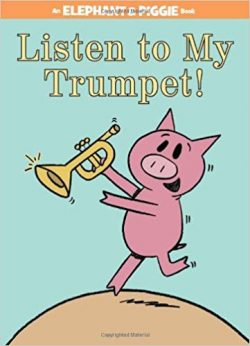
Listen to My Trumpet, Mo Willems
The elephant doesn’t know how to tell Piggy without hurting his feelings that he is not playing the trumpet very well. When he works up the courage to be honest, Piggy is incredulous: “Do you think I’m trying to play trumpet? I’m trying to talk Elephant!” The final page where Elephant is instructing Piggy to put more “ick” into his “gr-ick” when playing trumpet has us in stitches no matter how many times we read it. A great lesson in how false assumptions lead to miscommunication.

Pinkerton, Behave! Steven Kellogg
Steven Kellogg is a superb humorist, and he is sure to entertain your child (and you) with this book. Pinkerton is an adorable Great Dane with extremely poor manners. He doesn’t come when he is called, and he even destroys Mom’s slippers. When the family takes him to obedience school, he teaches other dogs how to disobey. But when a nasty burglar breaks into the house, Pinkerton saves the day. You will have to read the book to find out how. I guarantee that your kids will be laughing hysterically and begging you to read it again and again.

Heroes of the Surf, Elisa Carbone
A gripping true story full of sentiment and bravery, about how the United States Coast Guard came into existence. This is one that you will want to share over and over again. The year is 1882, and a large steamship carrying passengers to New York during a storm hits a shoal near New Jersey shore. The rescue operation in the dark with the waves crashing wildly all around is edge-of-the-seat exciting. The illustrations are spectacular, and when my oldest son read the library copy, he begged me to buy it.
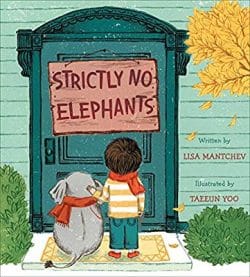
Strictly No Elephants, Lisa Mantchev
This is one of our favorites. A little boy discovers that he is not welcome because his pet doesn’t fit in. The drawing of a boy and his pet elephant taking a lonely stroll in the pouring rain will surely pull on your heartstrings. When he meets another person who was turned out of the Pet Club because of an unusual pet, they decide to start their own club where everyone is welcomed. I love the message of inclusivity and loyalty. Mostly full-page, expressive, and colorful illustrations are extremely fun to look at.

Fiona’s Luck, Teresa Bateman
A personal favorite of mine! Fiona’s Luck is a skillfully crafted story full of magic, spells, tests of wits, and suspense. What’s absolutely amazing is that it’s not an old fairytale but an original one by a contemporary American author. Once there was a lot of luck around but not anymore because the leprechaun king keeps it all locked up. With unflinching intelligence and ingenious plotting, Fiona gets the luck back from the leprechaun king, not a small feat since, as the legend goes, nobody can outwit a leprechaun.
The principal strength of the story is that all the parts fit so neatly that you can’t help nodding your head and thinking “yep, that’s exactly how it happened. It couldn’t be any other way” until you shake your head and remind yourself it’s a fairytale.

The Library, Sarah Stewart
Do you love reading and buying books? So did Mary Elizabeth Brown, the actual person behind this delightful historical fiction. She read everywhere, any time she got a minute, and bought books at an alarming rate until she accumulated so many books that her shelves began to fall apart and her front door was blocked by stacks of books.
I love the meter and pace of the story and have happily reread it thousands of times. “She read about Greek goddesses while vacuuming the floor. Attending only to her book, she’d walk into a door.” David Small’s soft, pastel-hued images are works of art. Each page is beautifully composed with humor and charm. I was very happy to learn that The Library got a Caldecott Honor Award.
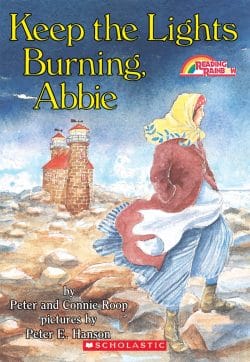
Keep the Lights Burning, Abbie, Peter & Connie Roop
There are many fabulous books about strong kids and this is one of the best. Abbie Burgess once kept the lighthouse lights burning for 21 nights without help, not much sleep, and only a little food (one cup of corn mush and an egg per day). She was only sixteen years old. She also saved the lives of her sick mother and younger sisters by moving them into a stronger part of the lighthouse (just before the furious ocean filled their regular quarters). It’s a true and very moving story that my kids refer to as “the book that makes mom cry.”
I love reading this book to my kids, even though it does make me cry sometimes. Not only is it expertly written, but it also has evocative watercolor pictures that warm my heart.

The Magic Horse of Han Gan, Chen Jiang Hong
Myth, legend, and the culture of ancient China, spellbound narration and suspense, and the most extraordinary silk paintings combine here to create one of the most fascinating children’s books I’ve ever read. This is a story that is impossible to forget. The physical setting and the general sensibilities combine to transport us to a different era (over 1,200 years ago), and the ending is a surprise.
The main character of the story is Han Gang, a Chinese artist, who was legendary for painting horses that looked alive. In this story, one of these horses does spring from the page and becomes a great warrior’s warhorse. All throughout, you will see splendid paintings of horses. I knew I had to buy The Magic Horse the moment we finished reading the library copy, so we could read it over and over again.

The Mysterious Tadpole, Steven Kellogg
In The Mysterious Tadpole, a Scottish uncle gives young Louis a tadpole for his birthday. After many hilarious adventures, we learn that the tadpole is actually a Loch Ness monster, a mythical creature from Scottish folklore. This is one of my kids’ favorite books. We’ve been reading it for years, and it still tops our all-time favorite books’ list.

Amazing Grace, Mary Hoffman
Grace is a spirited young girl who learns that she can be anything she wants to be if she puts her mind to it. She has a passion for acting and has been acting out adventure stories and fairy tales in her home for as long as she remembers. So when her class is doing a Peter Pan play, she knows she can be an amazing Peter Pan, but she is told that Peter Pan is neither black nor a girl. What’s Grace to do now?

Heckedy Peg, Audrey Wood
This edge-of-your-seat thriller is sure to set your kids’ pulses thrumming. Written in the best tradition of classical fairy tales and illustrated with magical paintings reminiscent of old masters, this dark tale of a witch that turns children into food is all-around captivating. A mother can get her kids back from a wicked witch only if she guesses each of her kids correctly. A loving mother would know her children anywhere. The happy ending in this heartwarming testament of a mother’s love is inevitable. Heckedy Peg is one of the best children’s books we have ever read.

Chopsticks, Amy Krause Rosenthal
With witty humor and delightful illustrations, the very talented Amy Krause Rosenthal tells a tale of the importance of sticking together while learning the art of standing on our own. Every time we read it, we discover a new joke, a new aspect of illustrations, or something else that slipped our attention on previous readings. This lovely book is one of my favorites.

Up the Mountain Path, Marianne Dubuc
This book is one of my favorites. Mrs. Badger is a wise old lady who greets old friends and helps creatures in need. She also teaches others how to be kind and brave, how to listen to intuition, and how to have faith.
Read this with your kids more than once and emphasize different aspects of the story. There is so much to discuss: opening your eyes, lending a helping hand, harmony with nature, enjoying the journey, passing on traditions, encouragement, friendships, and the cycle of life. If you are amazed that a children’s book can pack so much meaning, you’ll be even more amazed when you read it. From each word to the soft pencil and watercolor illustrations of serene forest scenes, this book is a treasure.
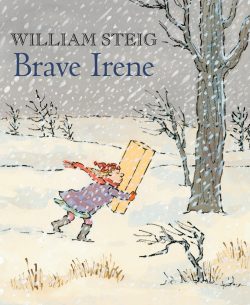
Brave Irene, William Steig
One of the most charming things about William Steig’s books is his ability to transport the reader into the action. In Brave Irene, we feel the biting wind and our muscles are quivering from the effort of trudging through deep snow in an epic snowstorm. We feel the horror when the wind tears the valuable dress from Irene’s hands and sigh in relief when the dress is found. This satisfying tale of bravery and courage has rich language, a suspenseful plot, expressive illustrations, and a sweet ending. It’s with great pleasure that we’ve been reading and rereading this book over the years.

Going Places, Peter and Paul Reynolds
The book’s main idea is to stop looking for a precise set of instructions, forget what everyone else is building, and let your imagination take you wherever it will. This is one of my favorite books on creativity for kids. It delivers an excellent lesson wrapped up in an entertaining format; it’s truly well written and illustrated. The book is a big hit with all my children. Every time we re-read it, they hold their breath as if they really don’t know who will win the race. (After reading this book, go to a furniture store and ask them if you can buy a giant box. Give it to your kids to build their own “go-kart.” They will have a blast!)

Cake Girl, David Lucas
Oh, I just love, love, love Cake Girl and my kids do too. I get requests to read it all the time. It contains all the perfect ingredients of a well-loved story: a magical plot, a set of delightful characters, and funny cartoon-ish illustrations. When a lonely witch bakes herself a Cake Girl, a cake shaped girl who comes alive (aka Gingerbread man), the witch is planning to eat her (Cake Girl) for her (Witch’s) birthday. But the clever girl comes up with a way to change the witch’s mind.
We discover the real reason the witch is mean is that she doesn’t know how to change. If you’ve been around small children, you know that sometimes they lack social skills, and other times they get locked in a bad mood because they don’t know how to snap out of it. So this book is a great way to address both issues. “Perhaps you could help me?” asks Cake Girl and the witch does. Yes, helping someone is the best way to snap out of self-misery and also to make friends.
Related: 20 Delightful and Yummy Books about Cake for Kids
Great Books with Great Lessons


The Ugly Pumpkin, Dave Horowitz
The classical story of the ugly duckling gets a fabulous reinterpretation in this modern farm parody. One by one, the pumpkins are picked and carried away from the farm, but nobody wants the ugly pumpkin. Wandering away to ease the pain of rejection doesn’t help until the ugly pumpkin discovers that he is actually a squash. The illustrations are full of expression and bright autumn hues. We love the rhyming, poetic text and think that this story makes for a very enjoyable read-aloud.
Lessons learned: If you feel like you don’t belong, go find your people. Oh, and also, rejection hurts, but it’s temporary. Nothing lasts forever, even a bad streak.

Little One Step, Simon James
We all love this sweet tale about three ducklings who get lost far away from home. The smallest one is not sure he can make it back to his mom, but he has his older brothers to cheer him on and to teach him an important life lesson that even long journeys start with one little step. It’s a great example for kids of how they can use words and actions to encourage and be nice to each other. The yellow-themed watercolor illustrations are extremely fun.
The lesson: A journey of a thousand miles begins with a single step.
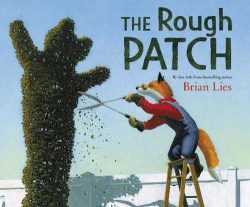
The Rough Patch, Brian Lies
The Rough Patch is a brilliant, beautiful, and touching book about Evan, who lives an ordinary life. He plays games, listens to music, and potters in the garden with his best friend until unexpectedly something extremely bad happens. This book is a great reminder that bad things happen, and when they do, all we can do is take small steps forward and remember the light at the end of the tunnel.
Lesson learned: When we feel sad, we can do something for others to make ourselves feel better. It doesn’t have to be much. We can smile and be friendly. We can stop and help. We can lend an ear, say “thank you,” and be more patient with others (and ourselves).

Poinsettia and Her Family, Felicia Bond
Each of my kids went through the stage when this was their favorite book and with good reason. It has playful drawings, humor, and an exciting plot. Poinsettia has six brothers and sisters, and they are getting on her nerves. One day she decides to stay home alone and tricks her family into getting in a car and driving away without her.
While her family is away, Poinsettia has the time of her life. She doesn’t have to wait for her turn, watch her manners, or limit her bath time. But her family gets stuck in a snowstorm and doesn’t return for a very long time. It gives Poinsettia the opportunity to realize something very important about her family.
Lesson learned: When your family is driving you crazy, find the right perspective. Is it really such a big deal? Is it possible to find a compromise? Can you find a grown-up to talk about it?
Related: Books to Foster Positive Sibling Relationships
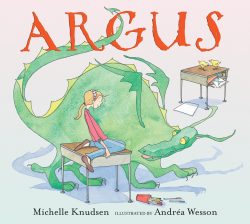
Argus, Michelle Knudsen
Sally’s class is raising chicks for a science project; only Sally’s chick seems to be more inclined to eat other chicks or even students than to behave like an ordinary bird. Sally would do anything to have an ordinary chick just like everyone else until the day something unexpected happens. We all love this humorous, heartfelt book. And the ink and watercolor illustrations are very enjoyable.
Lesson learned: Take care of what is given to you. And don’t make fitting in your criteria for success in life.

When You are Brave, Pat Zietlow Miller
Sometimes we might feel “Too small. Too quiet. Too tired. Not enough.” We wonder about what lies ahead, and the world might seem “Too big. Too loud. Too hard. Too much.” That’s when we can use our minds to change the way we feel.
We love the illustrations, the plot, and the idea that even though life doesn’t always go the way we want to or the way we planned, we can use our minds to be ok about it. The mental exercise the little girl does in the book will be useful to all who want to feel more confident that they can handle whatever life throws their way.
Lesson learned: No matter what happens, we will be okay.

The Duckling Gets a Cookie!? Mo Willems
The moment you read The Duckling Gets a Cookie on the title page, accompanied by a drawing of a pigeon with his hands on hips who grumbles, “I do not like the look of that title,” you know you’re gonna love it. Mo Willems’s flair for the comical and his extraordinary ability to convey so much emotion and passion with just a few strokes of a pencil make all of his books genuinely entertaining.
Lesson learned: Making your request politely is more likely to bring about the desired effect.
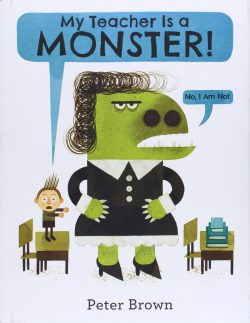
My Teacher is a Monster, Peter Brown
Bobby is convinced that his teacher is a monster, but a pleasant day in the park with the teacher by his side convinces him otherwise. We love how with the change of perspective, page by page, the monster morphs into a human. Great book! My kids sometimes rush to put labels on people and events: “This museum is stupid” (in the first room of the first floor). This is a great book about prejudice and problems with quick judgments.
Lesson learned: With time and a little more information, our perceptions, judgments, and opinions can change.

Iggy Peck, Architect, Andrea Beauty
Poor Iggy has no luck. His mom and his teacher conspired to discourage his dreams and stop his creative projects. Luckily, though, Iggy’s engineering genius saves the day, and his teacher realizes that there are worse things in life than an interest in architecture. This book undoubtedly will spark curiosity about architecture in any kid. Also, check out Iggy Peck’s Big Project Book for Amazing Architects.
Lesson learned: When no one around you supports your dreams, remember anything is possible and don’t give up.
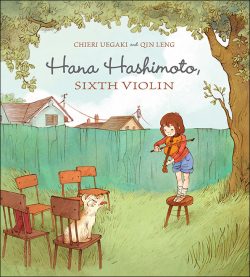
Hana Hashimoto, Sixth Violin, Chieri Uegaki
Hana’s grandpa can pluck the strings of a violin to mimic the sound of raindrops, make his violin chirp like crickets, and compose melodies that can make fireflies glow brighter. Hana gets so excited about learning to play the violin that after only three lessons, she signs up for a talent show. Her brothers think she will be a disaster, but she surprises them. It’s a beautifully written and gorgeously illustrated picture book about bravery, and the value of practice, dedication, and commitment.
Lessons learned: You’re braver than you think you are.
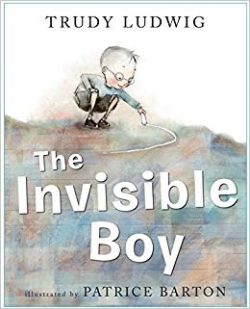
The Invisible Boy, Trudy Ludwig
Bravery doesn’t always mean climbing into burning buildings and saving lives. Most acts of bravery are small but important. In The Invisible Boy, bravery involves taking the first step, showing empathy, and making an effort. Those are all acts of bravery that kids can practice every day.
Lesson learned: Bravery doesn’t always feel like bravery, but it has the power to lift people—and that’s priceless.

Exclamation Mark, Amy Krouse Rosenthal
An exclamation mark has an existential crisis. It doesn’t seem to fit in with the other punctuation marks and has little confidence in itself. But then a question mark enters the scene and helps the exclamation mark discover its strengths. This clever and humorous book is one of our favorites.
Lessons learned: Self-discovery is important, confidence comes from within, and fitting in is not a requirement for a happy life.
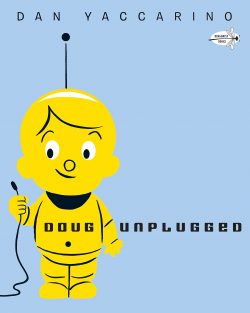
Doug Unplugged, Dan Yaccarino
Doug’s parents want what’s best for their son. That’s why every day, they plug him into a computer, and he fills up with lots and lots of facts. How many gallons of water city fountains pump every minute, how many floors are in the tallest skyscrapers, and that pigeons… When a real pigeon lands on his window sill, Doug learns something that wasn’t in the download.
My kids were delighted to talk about the possibility of being raised by robots. They also reflected on how their lives would be different if, in order to learn something, all they did was plug themselves into a computer. The minimalist art and the skillfully disguised lesson on the benefits of hands-on learning are fantastic. This book is a must for all robot lovers.
Lesson learned: Put that iPad down and go outside.
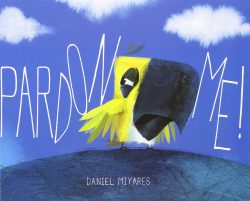
Pardon Me! Daniel Miyares
The story starts with a little bird that just found a sweet spot where it could rest. But the peace is short-lived as other creatures discover the nice spot and join the bird. Finally, something so completely unexpected happens that you will be exclaiming, “it’s brilliant,” at the same time as your kids will be flipping the book back to the beginning and shouting, “Read it again!”
Lesson learned: Be kind. Always.

Rotten Richie and the Ultimate Dare, Patricia Polacco
In this story about getting along, irony, and acceptance, Patricia Polacco shares the time in her childhood when she and her brother had underestimated how much training goes into each other’s hobbies. Her brother thought that ballet was just a bunch of twirling around that he could do with his eyes closed. And she thought that hockey was just a bunch of skating in circles with a stick. They are both in for a bit of a surprise when they have to (literally) step into each other’s shoes. The author’s expressive, comical, adorable drawings are perfect for the story, and we love the addition of family photographs.
Lesson learned: Don’t judge a person until you have walked a mile in his shoes.

The Wump World, Bill Peet
This book was an instant hit with all of my children. I knew it would be because they love wildlife, and conservation and preservation issues are close to their hearts. In this story, a group of Pollutians arrives on a planet called The Wump World. They quickly colonize the planet, build roads and skyscrapers, and keep building until the water and air are completely polluted. At this point, Pollutians get into their spaceships and take off in search of a better life elsewhere.
Tragically, the original inhabitants of the planet, the Wumps are left to deal with what’s left. Even though there is a bit more text than is typical for a children’s book, the drawings are beautiful and engaging, making it a captivating book for all levels.
Lesson learned: Be gentle with Mother Earth. We don’t have another planet to escape to when this one falls apart.

Piper, Emma Chichester Clark
Piper was a huge hit in my house. It especially thrills my 6-year old who wants to read it over and over again. Piper is a dog with a kind heart and some strong beliefs about what’s right and wrong. So when his new owner orders him to be vicious, he refuses, even if it means punishment. The story has a sweet ending. The beautiful illustrations by the author intensify the story.
Lessons learned: Injustice happens and it sucks. But stand up for your beliefs, and always be kind.
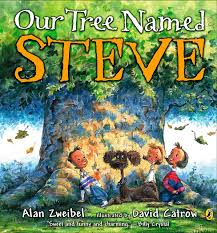
Our Tree Named Steve, Alan Zweibel
This story’s main character is a tree. It gives shade. It gives a place to hide. It holds a swing and a jump rope. It becomes the center of all the backyard happenings from barbeques to campouts. Most importantly, it gives this family “peace that comes with having things you can count on and a safe place to return to after a hard day or a long trip.”
But one day it has nothing left to give except for falling down in such a way that it doesn’t crash onto the family house. The story is written in the form of a letter, and if you know me enough by now, then you probably have guessed already that the story made me cry.
Lesson learned: Not all changes are welcome, but don’t fight life. If you can’t change it, let it be.

Ribbit, Rodrigo Folgueira
This is a super adorable book about a little pink pig who sits on a rock and says, “ribbit.” The pond frogs are utterly confused: What’s he saying? Is he making fun of them? They go to an old beetle for advice and realize that pig is learning the frog language to make friends with frogs. By the time they have figured that out, the pig is already in the tree speaking “tweet” with his new bird friends.
Did the frogs lose out on a chance to make a good friend? Oh no! They take a page out of pig’s book and at the end of the story, you will find these frogs up in a tree along with some other animals all tweeting together. It might be one of the best books on friendships we have ever read.
Lessons learned: Sometimes you will be rejected, but you’re strong enough to stand alone. And also, give others second chances.

The Better Tree Fort, Jessica Scott Kerrin
Russell thinks his treehouse is perfect until he sees a better tree house three houses over. But when he visits the boy with a better treehouse, he discovers that the boy’s head is filled with thoughts about an even better tree fort with a kitchen sink. It’s a cute and funny story and I’m absolutely in love with Qin Leng’s artwork. She uses ink, pencils, and watercolors to a delightful effect.
Lesson learned: There will always be someone with better and bigger things. What we should do is enjoy and appreciate what we have.
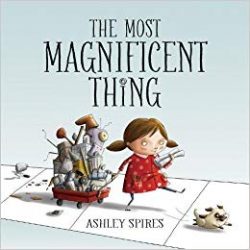
The Most Magnificent Thing, Ashley Spires
We’ve been reading The Most Magnificent Thing for a few years and never get tired of it. Through humorous and expressive (one might even say magnificent) drawings, the award-winning Canadian author tells a story of a creative girl who knows exactly how her project is supposed to look and work, only it doesn’t come out right on the first (and even tenth) time.
Lesson learned: If it doesn’t work right away, try and try again.

The Cello of Mr. O, Jane Cutler
This is one of the most touching music stories I’ve ever read. I originally stumbled upon this title when my son and I started to take cello lessons. I didn’t know anything about the book when I ordered it. When it arrived in the mail, I stood by the front door, opened the package, and read the book’s first line out loud: “Here we are, surrounded and under attack.” “Go on!” shouted my kids, “you can’t stop now!” I sat down on the floor right where I had stood and read this heartwarming story about a war-torn city, the power of music to make us feel better, and the resilience of the human spirit. I cried real tears when a Nazi blew up the cello, and I cried, even more, when the cello player kept making music without the cello. It’s one of those stories when all my kids just froze and didn’t appear to breathe for the story’s duration.
Lesson learned: You get to choose your attitude and that’s a freedom that no one can take away from you.
Related: Inspiring Children’s Books for Kids Who Are Learning to Play Musical Instruments
Mind-Expanding Books


I’m Trying to Love Math, Bethany Barton
In I’m Trying to Love Math, an unseen, unspecified narrator (who we presume to be a human child) and an alien have a humorous conversation about math. The alien, whom we lovingly refer to as ET, opens the narrator’s eyes to the fact that math is all over the planet Earth and is a huge part of our daily life. Pen-and-ink art is amusing and a huge part of the book’s success with my kids. The story’s main idea is that when children say they don’t love math, they typically refer to boring worksheets, but real-life math, like a recipe for delicious cookies or music, is easy to love.
Mind-expanding fact: you already love math. Unless you hate cookies, flowers, and music.
Related: 9 Amazing Math Activities You Will Want to Try
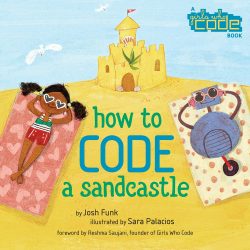
How to Code a Sandcastle, Josh Funk
You will want this book in order to introduce your kids to the fundamentals of coding in a fun way. In this beach story, a girl is trying to build a sandcastle with the help of a robot. She gives him different commands and discovers that sometimes he takes things a bit too literally. When she tells him to bring something for decoration, he brings her a lifeguard. “IF the item you see is small and doesn’t move and doesn’t belong to anyone THEN bring the item back to the castle or ELSE find something different,” she clarifies, and things go a bit smoother after that. This book might inspire your curious kids to try coding. If that happens, check out Bits box. We’ve been using it in my house for over a year with fabulous results.
Mind-expanding Fact: Coding is all about perspective-changing. You look beyond your point of view and communicate in the language that computers can understand.

Are You Ready to Play Outside? Mo Willems
Here’s a great book to remind us that playing outside can be fun in any weather. When Elephant and Piggie get all pumped up about playing outside, it starts to rain like it never rained before. Piggie is not happy until he decides to “try” to have fun anyway. The two friends skip in puddles, splash, and begin having all sorts of wet fun just as it stops raining. Can they make the most of this new development? It’s Mo Willems, so you know the book will be hilarious, and your kids will love it.
Mind-expanding fact: Things don’t have to be exactly the way we want them to be in order for us to have fun.
Related: more books about playing outside, swimming, picnics in the park, and digging in the garden
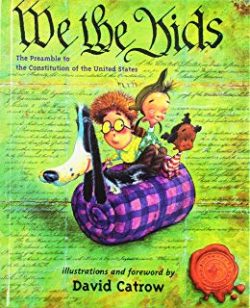
We the Kids, David Catrow
“We the Kids of the United States, in order to form a more perfect union…” David Catrow created the most adorable way to learn and understand the preamble of the constitution. After we got home from the library, my eight-year-old read the book while I was cooking dinner. I saw her giggling the whole time, and then she brought it to me with, “That’s such a great book! You have to read it, Mom!” I’ve since read this for storytime with all of my kids multiple times. Even my toddler and my tween love it.
If you’re familiar with David Catrow’s work, you’ll recognize his signature bright, comical, cartoonish watercolor illustrations. Follow up the reading by a discussion about justice, freedom, and welfare.
Mind-expanding Fact: The Constitution might be full of extravagantly big words but they mean simple things that have relevance to all of us.

What Do You Do With a Problem? Kobi Yamada
Once in a while, my kids get frustrated that their projects don’t turn out the way they hoped. What kids need to know is that they get better with every project even when it doesn’t come out looking exactly as what they had in mind. This attitude is what Carol Dweck calls a growth mindset or a belief that you can learn and grow from the effort. There are many things parents can do to encourage a growth mindset including reading books.
Mind-expanding Fact: Problems push us to be better and more inventive.
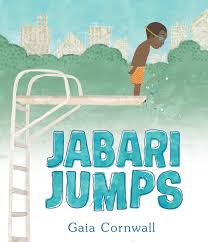
Jabari Jumps, Gaia Cornwall
As a kid, I loved books about courage. Somehow, they made me feel braver. In Jabari Jumps, we meet a young boy who passed his swim test and is ready for the next hard thing—jumping from a diving board into a swimming pool. But the ladder is very long, and he’s not sure he is up to it today.
My favorite moment in the book is when Jabari’s dad tells his son that taking a deep breath and saying “I’m ready” helps him to work up the courage to do something scary. Gaia Cornwell’s specialty is making patterns for surface designs, and her creative illustrations reflect her passion.
Mind-expanding fact: Your mind believes what you tell it.
Related: Picture Books about Swimming for Kids

Violet the Pilot, Steve Breen
Violet lives in a boat-shaped house next to a junkyard her family owns. From an early age, she loves tinkering with junk more than anything else in the world. An air show competition inspires her to make her best invention yet, The Flying Hornet. But an unexpected turn of events prevents her from ever reaching the competition.
A lot of children’s books cover tinkering and invention, but not many have such a satisfying ending. This book will have your kids jumping up and down in excitement, grinning from ear to ear.
Mind-expanding fact: Sometimes not winning is how you get ahead.
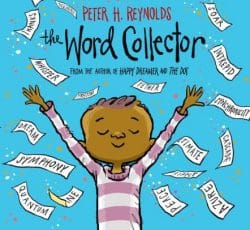
The Word Collector, Peter H. Reynolds
If you think a book about words can’t be a page-turner, you don’t know enough about Peter Reynolds. He weaves together dynamic stories, and his artwork is amazing. I love that the story teaches kids to look for words everywhere. The boy in the narrative writes down words he has heard, seen, and read. One of my favorite pages is when the words become jumbled and form unusual pairs: “dream cloud,” “blue harmony,” and “silent orchestra.” This book is a must-read!
Mind-expanding fact: The simplest words are the most powerful: “I understand.” “I’m sorry.” “You matter.”

Here We Are: Notes for Living on Planet Earth, Oliver Jeffers
Oliver Jeffers is one of our favorite authors/illustrators. You might know him as the author of The Incredible Book Eating Book and the illustrator of the hugely popular The Day the Crayons Quit. Here We Are is a book he wrote for his newborn son as a user’s guide to life on earth. It’s a sweet demonstration of just how amazing our planet is and that no matter what, we are never alone. I wasn’t surprised to learn that this book was A TIME Magazine Best Book of the Year and a #1 New York Times bestseller.
Mind-expanding fact: You’re spinning on a ball called Earth in the middle of nowhere and you get to decide what you want to do with your time here.
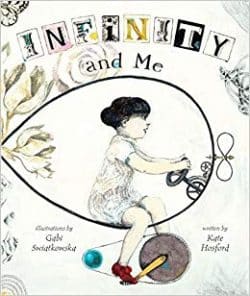
Infinity and Me, Kate Hosford
Infinity and Me explore the idea of thinking as a way to interact with the world. And it provokes many different conversations about science and the philosophy of life. Would you want to be eight years old forever? Would you want to eat your favorite ice-cream for eternity? How many times can you cut a noodle in half? Do you know the names of your grandparents’ parents? The whimsical illustrations by very talented illustrator Gabi Swiatkowska make this seemingly complex book interesting for even little kids.
Mind-expanding Fact: Never stop asking intriguing questions.

The Bad Seed, Joey John
I think the reason my kids like this book so much is because they like the reassurance that misbehaving doesn’t make them bad. If they say something mean, or do something impulsive, a thoughtless thing that at times characterizes kids’ behavior, there is hope. At any moment in time, they can choose to make the right choice. It might not always work out (keeping cool and sharing is hard, even for some adults), but they can keep trying. The other reason is that the writing is funny and the illustrations are playful.
Mind-expanding fact: We have no obligation to be the same person as we were yesterday.
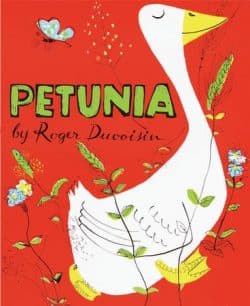
Petunia, Roger Duvoisin
This book follows the adventures of a silly goose by the name of Petunia, who overheard her farmer say, “he who owns books and loves them is wise.” So when Petunia finds a book in a meadow, she decides to love it. Now that she owns AND loves a book, she is convinced of her wisdom. Unfortunately for the farm animals, Petunia’s attempts to act wisely bring about disastrous (but humorous) consequences. The story ends with Petunia’s decision to learn how to read.
Swiss-born author and illustrator Roger Duvoisin is a Caldecott medalist and a master of expressive artwork. This is easily one of our favorite books. We love the creative plot, hilarious illustrations, and the lesson that wisdom doesn’t come from objects but the mind.
Mind-expanding fact: Knowledge is power. Effort matters. And it’s never too late to start moving in the right direction.
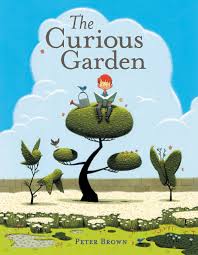
The Curious Garden, Peter Brown
In the world where gardens, trees, and greenery of all kinds have disappeared, Liam finds a curious thing—a patch of wildflowers and plants on the abandoned railway tracks. Liam is not a gardener, but he is willing to try different things to find what works until something incredible happens, and the world becomes green again.
Mind-expanding fact: Small actions can make a huge difference when done consistently and with passion.
Biographies
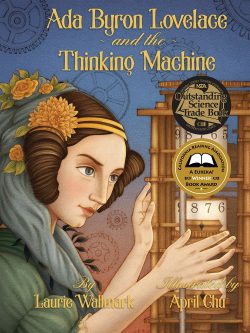
Ada Byron Lovelace and the Thinking Machine, Laurie Wallmark
Ada Byron Lovelace was an early English mathematician. Ada’s mom hoped that rigorous academic studies and self-control exercises would prevent her daughter from taking after her dad (famous poet Byron who is now believed to have been a psychopath), and hired the best tutors to train her daughter’s mind. Thus, in the milieu of early Victorian high society, a girl appeared whose head was filled with numbers and the computational possibilities rather than petticoats and suitors.

The 39 Apartments of Ludwig van Beethoven, Jonah Winter
This one is one of our favorites. In this vibrant story, the author sets out to investigate why Beethoven lived in 39 apartments in and around Vienna. Historians still don’t know for certain why Beethoven moved so much and how he managed to move five pianos in and out of small doorways, attic studios, and basement flats. But Jonah Winter’s has come up with a very creative take on the whole affair.
Despite the hilarity and humor, this book is an examination of human suffering. Can you imagine how it must have felt to be the best composer in the world and to be absolutely deaf? No wonder he lost his mind!

The Shark Lady, Jess Keating
The Shark Lady is a powerful and inspiring true story about Eugenia Clark, a woman who devoted her life to studying sharks. Faced with enormous obstacles, Clark didn’t surrender but rolled up her sleeves and got to work breaking stereotypes about girls and sharks one myth at a time. The illustrations are beautiful, and the moment we saw this book, we knew we had to buy it.
Related: Girls Can Do Anything: a book list to inspire your daughter

A Boy, a Mouse, and a Spider: The Story of E.B. White, Barbara Herkert
This gorgeously illustrated picture book biography of E.B. White will help you discover the man behind the famous stories: his childhood surrounded by animals; his love of nature; his work for a New York magazine; and his marriage, children, and a dream house in Maine. You’ll also learn how writing filled him with joy from an early age and how he came up with ideas for Stuart Little and Charlotte’s Web. The brown-ink-and-watercolor drawings are just stunning.

Who Says Women Can’t be Doctors, Tanya Lee Stone
In this book, we learn a thrilling biography of Elizabeth Blackwell, who became the first female doctor. There are many reasons to love this book—spunky narration, talented artwork by Marjorie Priceman (How to Make an Apple Pie and See the World), the inspiring subject matter, and the message not to let “them” decide what you can and can’t do. But the most amazing thing about this book is its power to ignite a meaningful conversation about obstacles, challenges, persistence, dreams, and courage.
Related: Girls Can Do Anything: a book list to inspire your daughter

Balderdash! John Newbery and the Boisterous Birth of Children’s Books, Michelle Markel
Did you know that before 1726, children only had religious texts and preachy fables to read? John Newberry, who became known as the father of children’s books, changed all that. A farm boy with a love of books, he apprenticed to a printer at an early age, and as soon as he could, he became a publisher himself. He worked incredibly hard, overcame lots of hurdles, and, most importantly, came to a fortunate resolution that “reading should be a treat for children.”
This story combines the best elements of a thrilling read—marvelous narration, amazing illustrations by our favorite illustrator Nancy Carpenter, and unique font.

Stone Girl, Bone Girl: The Story of Mary Anning, Laurence Anholt
An amazing true story about a little girl obsessed with dinosaurs in the 1800s. At the age of ten, after her father’s death, Mary Anning helped her family financially by scouring the crumbling cliffs of Lyme Regis for fossils. The fossils were then sold to tourists and scientists. She ended up uncovering Ichthyosaurus, Plesiosaur, and Pterodactyl skeletons.
In the process, she taught herself anatomy, geology, and many other scientific disciplines, becoming a pioneer in the field of paleontology (the study of fossils). Although she wasn’t very respected during her time (she didn’t have an official science background and was poor), her name is now in the halls of fame of the greatest fossil hunters of all time.

Nadia: The Girl Who Couldn’t Sit Still, Karlin Grey
This book will resonate not only with kids interested in competitive sports but with all the kids who were ever told, “Why can’t you sit still!” Nadia Comaneci, who is one of the most famous gymnasts in the world, was once a little girl who couldn’t sit still. During her career, she broke many gymnastics records and became the first gymnast EVER to get a perfect “10” score. Charming illustrations are full of movement and make you want to jump up and make a cartwheel. We made an Activity Pack to go with this book, and it includes some links that Karlin Grey, the book’s author, sent me.
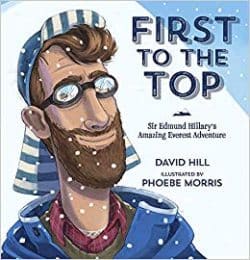
First to the Top: Sir Edmund Hillary’s Amazing Adventure, David Hill
Little Ed was a small and shy boy from a little town in New Zealand who dreamed of adventure. By the time he grew up, he was tall and strong, and become the first person to reach the top of Mt. Everest, the world ‘s highest peak. My kids were impressed with how much preparation, training, and hard work goes into climbing. They also were shocked to find out that the actual climbing isn’t the only hard part. Lugging tents, food, oxygen, and other supplies while climbing is just as challenging.
This is a great book about courage to explore the environment where each step can be your last, as well as determination to conquer the unforgiving terrain despite the pulse-stopping cold. Colorful illustrations and engaging writing make this biography accessible even to small kids.

The Glorious Flight: Across the Channel with Louis Bleriot, Alice and Martin Provensen
This is the true story of a man who didn’t let obstacles get in the way of his big dream. When Louis Bleriot saw the first airship flying over his city, he decided to build his own flying machine, and he did …eight years and hundreds of crashes later. On July 25th, 1909, Louis Bleriot became the first man to make an international overseas flight by crossing the English channel. For this and his further contributions to the field of aviation, he was inducted into the International Air & Space Hall of Fame. The book is written with wit and humor. And the captivating artwork won a Caldecott Medal.
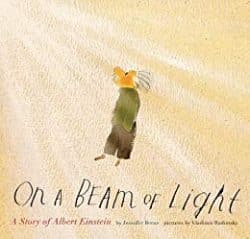
On a Beam of Light: The Story of Albert Einstein, Jennifer Berne
Discover the story of a little boy who was scolded in school for being different from others, who asked too many questions, and who liked to spend his time wondering, thinking, and imagining. This little boy became Albert Einstein, the scientist who changed the world. With this book, Jennifer Berne has done something seemingly impossible: she has made Albert Einstein exciting to little kids. The writing flows well, and the story is filled with great information.
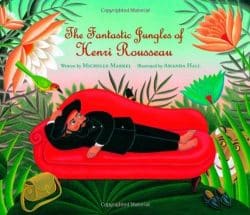
The Fantastic Jungles of Henri Rousseau, Michelle Markel
Whether or not your children have ever heard of the artist Henri Rousseau, they will be utterly impressed by this colorful biography. At the age of 40, he decided to be an artist. The only problem was that he’d never had any artistic training, and he was too poor to take art classes. But he didn’t let anything stop him. He worked as a toll collector and spent his whole salary on art supplies and started to teach himself to paint. Harsh critics kept saying that his work was childish and awkward. But Henry Rousseau kept painting. Today his work lives in the most prestigious art museums around the world.
Funny Books
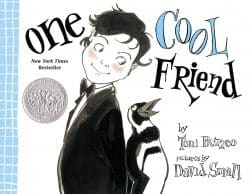
One Cool Friend, Toni Buzzeo
This is one of the funniest books we’ve ever read. A very polite little boy, a comically absentminded father (or is he really?), and an adorable penguin who through misunderstanding comes to life in their home: there’s nothing predictable about this Caldecott Honor Book. Ink and watercolor illustrations are evocative and enhance the hilarity of miscommunication. In the end, the confusion is cleared up with unexpected and adorably twisted results.

Fall is not Easy, Marty Kelley
This is the kind of book that you finish with a smile on your face no matter how many times you’ve read it before. And perhaps you’ll even exclaim, “That’s just brilliant!” I’m not sure what’s the secret ingredient that makes it so good. The story and the drawings are simple and a bit silly, yet the overall impact is smashing.
The tree in the story believes that he is not doing autumn right, but we, as readers, see that he is doing quite all right. One message of the book is accepting oneself for what one is. Another message is not being overly judgmental about the outcomes of our creative endeavors. The book fills us with a sense of endless possibilities. Often when we finish the book, my kids start coming up with crazy and funny suggestions for the tree’s artwork.

It’s Not Jack and the Beanstalk, Josh Funk
It’s Not Jack and the Beanstalk is a hilarious book my kids love to pull off the shelf often and look for more fun things they missed on previous readings. As usual, Funk is a master of weaving together an exciting tale with unexpected details, twists, and turns.
In this story, there are three voices. A Narrator, who is trying to tell the story of Jack and the Beanstalk in a traditional style. Young Jack, who is a rock-climber and has his own ideas about how the story should go. And a peaceful Giant, by the name of Fred, who is a vegan. As you can imagine, this setup is ripe with opportunities for humor. I just love imaginative new takes on old classics, don’t you?

Wolf Camp, Andrea Zuill
We always have a great time reading this humorous book. An adorable dog by the name of Homer loves nothing better than his electric blanket and Grandma Polly’s Pampered Pooch Doggie Snacks, decides to get a taste of the wild. In the wild camp, run by two bona fide wolves, Homer tries his hand (read: his paw) at hunting, eating raw food, and sleeping under the stars. All of these turns out to be far less enjoyable as Homer imagined they would be. As you can picture, the situation is full of opportunities for laugh-out-loud antics.
One of my favorite parts of the book is about the evolution of dogs. After a series of hilarious calculations comparing apples and bananas titled DNA proof, we read “This scene might not have actually happened.” It gives parents an excellent opportunity to talk about what makes a statement scientific and why kids shouldn’t believe everything they hear from friends or read in books.

Space Case, Edward Marshall
Space Case is not only our favorite UFO book; it’s one of my most favorite children’s books of all time. When a UFO lands on the corner of Maple and Elm, nobody seems very surprised. Perhaps that’s because it’s Halloween night and everyone looks a bit strange. But when Buddy takes the UFO home, his parents are sure to figure something was not right. Or will they? The story is absolutely hilarious. The artwork is enjoyable. This book calls out for multiple readings!
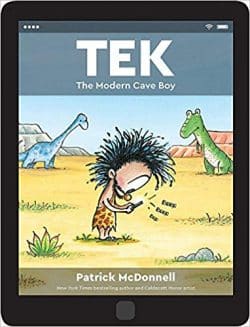
Tek: The Modern Cave Boy, Patrick McDonnell
This imaginative and unique book is a favorite with everyone in my house. It’s made to look like an i-pad complete with a battery icon that is draining with each page you read until it reaches zero. The story is about Tek, your typical troglodyte child, who is addicted to his phone, tablet, and game box. He never wants to leave his cave and misses the Ice Age and would have missed the whole dinosaur period, too, if only volcano eruption hadn’t crushed his gadgets.
The writing is funny, and so are the illustrations. The whole premise is adorable and a great tool for talking about technology obsession and being addicted to one’s own “cave.”

Little Red and the Very Hungry Lion, Alex Smith
Is there a new way to tell the Little Red Riding Hood tale? You bet! This Little Red is living in the savanna, and she needs to deliver face spot medicine to her auntie. The Very Hungry Lion has “a very naughty plan” to eat both Little Red and her aunt, but he is not a match for the spunky little girl.
Each page of the author’s imaginative, vibrant, and interactive illustrations invite hours of exploration. Little details, like glasses on the giraffe’s nose, the crocodiles’ tea party, or the baby elephant’s grocery basket, delighted my children.

Are you Scared, Darth Vader? Adam Rex
In this brilliant and hilarious book, Adam Rex, the bestselling author of Frankenstein Makes a Sandwich, gives young readers the power to blast away the iconic villain by … closing the book. The assortment of scary ghosts, bats, and vampires do not scare Darth Vader. A noisy crowd of energetic and overly enthusiastic children does not scare Darth Vader. Do you know what scares Darth Vader? A child who is reading the book! Because the child has the power to turn the last page and … bye-bye, Vader!
This book’s artwork is absolutely adorable. The black background with yellow font and creative print is pleasing to the eye. The illustrations are an imaginative combination of 3-D models, photography, drawing, painting, and digital work. This energetic and entertaining book has all my Star Wars enthusiasts in stitches.
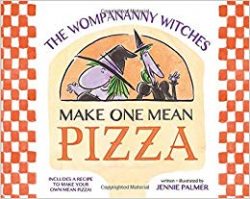
The Wompananny Witches Make One Mean Pizza, Jennie Palmer
When two witches pounded all their angry/anxious feelings into a fresh dough, they ended up baking such a mean pizza that it knocked their door down and went into town to terrorize the general population. But even a mean pizza is no match for a bunch of very hungry children.
We love this book and think it’s very funny. And when your kids are out of sorts, you can suggest they pound their feelings into the dough. By the time they are eating freshly baked bread or pizza, they will be all smiles.
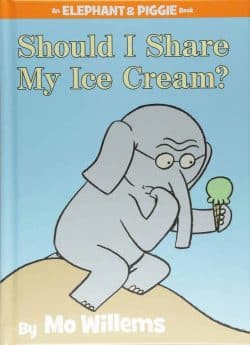
Should I Share My Ice Cream, Mo Willems
On a hot summer day, while Elephant is trying to decide if he should share his ice cream cone with Piggie, his best friend, the ice cream melts. Oh no! You wouldn’t believe what Piggie ends up doing for Elephant to cheer him up. Or maybe you’ll figure it out. But don’t worry. Even if you do, you’ll still enjoy the book because it’s Mo Willems, the funniest children’s author of our times, and he never disappoints. Humor aside, the book will teach kids a valuable lesson about sharing.
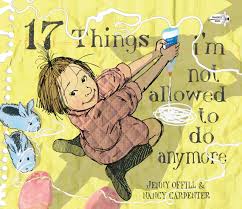
17 Things I’m Not Allowed to Do Anymore, Jenny Offill
Parents so often give children contradictory messages. They say they want kids to be creative, inventive, and unique, but so often they discourage the behavior they say they want. In this story, a girl is full of brilliant ideas that always get her in trouble. No matter how many times we read this book, it makes us laugh out loud. The illustrations by Nancy Carpenter are an integral part of the story.
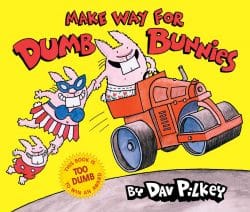
Make Way for Dumb Bunnies, Sue Denim
“Early one morning, the Dumb Bunnies were spending some quality time apart… [but as] dark clouds rolled in, and thunder flashed brightly,” they decided it was a good time to go to the beach. Of course, being as dumb as they are, the bunnies just can’t get anything right. My six-year-old can’t stop laughing and pointing out how they can fix their mistakes. My two older kids still love it, too, and keep asking how they can become as funny as Sue Denim. Sue Denim has a gift for light and silly humor that appeals to kids.

Nuts in Space, Elys Dolan
My kids regularly pull this laugh-out-loud book from the shelf and read it in full or in part. Speech bubbles, thought bubbles, funny labels, hilarious characters, snappy dialog, and inventive plot combine to create a story that is a joy to read over and over again. It’s also one book that my two boys love to read and discuss together: it’s their bonding thing.
The crew of the Forest Fleet’s finest starship is under orders to bring the Lost Nuts of Legend from the very edge of deep space. Commander Moose, Navigation officer Owl, and the rest of the animals are very hungry, but it’s nothing compared to their troubles when they meet The Death Banana crew. My kids tell me it’s a parody on Star Wars: New Hope.

Meet the Dullards, Sara Pennypacker
This might be the funniest children’s book I’ve ever read. The first time I read it, I was laughing so hard, I was gasping for air. However, after recommending this book to many friends, I learned that not everyone agrees.
On the surface, this book is about a dull family that avoids books, the TV, and excitement of any kind. But on a deeper level, it’s a parody on the banality of life, the triviality of most daily choices, and the dullness of most people’s existence.
For this mom and dad, watching paint dry is fun, and noticing a snail crawling through the driveway produces too much excitement. But kids always find a way to find the extraordinary in the ordinary, and before you know it, their three children join the circus
My kids all love this book, but for a totally different reason. Their focus is on the kids’ quest for a circus adventure and the hilarity of the illustrations. You should see the look of horror on parents’ faces when they find their kids reading.
I think if you love humor by exaggeration, deadpans, parody, and satire, you will enjoy this book.

How to Teach a Slug to Read, Susan Pearson
How to Teach a Slug to Read is a funny story that will help your kids appreciate how much patience and effort is put into teaching. It has humorous cartoony illustrations and clever slug parodies on popular children’s books (The Slug in the Hat). My kids adore all the Slug Nursery Rhymes. “Little Miss Muffet sat in a tuffet eating her curds and whey. Along came a slug and gave her a hug and told her to have a nice day.”
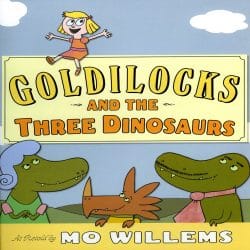
Goldilocks and the Three Dinosaurs: As Retold by Mo Willems
This hilarious story relates the misadventures of three dinosaurs—Papa Dinosaur, Mama Dinosaur, and “some other Dinosaur” who was visiting from Norway. “Har! Har! Horjfsk! Huugrk!” It might sound to you like an evil laugh, and it very well might be, but it can also be a polite Norwegian expression.
The three hungry dinosaurs are hoping to catch a poorly supervised human child, and to that effect, they cook three bowls of chocolate pudding at various temperatures. The double-spread illustration of Papa using a thermometer and ice to bring the puddings to the right temperatures, while the other two dinosaurs set up beds and chairs in the background, is too funny for words.
This book will have you and your kids rolling on the floor laughing. Mo Willems is the best!

Plantzilla, Jerdine Nolen
When a third-grade science teacher started a plant appreciation program, he said to his students that “caring for plants in this program gives more benefits than you could ever imagine.” Does it ever! From the moment Plantzilla became Mortimer’s houseplant, suspicious things started happening all over the house. Mortimer even thinks that Plantzilla can move on its own. Creepy? Nah, pure fun! Read this book. It’s FUNNY!

Slugs in Love, Susan Pearson
This is the funniest Valentine’s Day book we’ve ever read. “Marylou loved everything about Herbie —how his slime trail glistened in the dark, how he could stretch himself thin to squeeze inside the cellar window, how he always found the juiciest tomato.” Thus begins a hilarious tale of slug love, bad luck, and slime rhymes. The illustrations are cute and full of humor. I know you will enjoy reading this book as much as we did.

Diary of a Wombat, Jackie Wombat
In this hilarious book, we get a glimpse into the life of an Australian wombat and her interactions with humans. Who knew wombats could be so mischievous and so funny? The book concludes on an optimistic note that “humans are easily trained and make quite good pets.” All my kids say that it’s one of the funniest children’s books we have ever read.
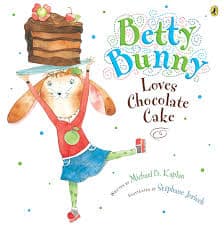
Betty Bunny Loves Chocolate Cake, Michael B. Kaplan
All of my kids adore this funny book about a bunny who loves a chocolate cake (perhaps) a bit too much. The watercolor illustrations are vibrant, the plot is thick, and it’s a great pleasure for kids to feel wiser than Betty Bunny. We love reading books that feature a cake so much that we made a list of our favorites (about a dozen more cake books didn’t make the cut). 20 Children’s Books about Cake

Listen Buddy, Helen Lester
I’m not completely sure what exactly creates the attraction in this book, but all my kids went through a stage when reading it a few times each day was a must. The story is about a bunny who’s head is always up in the clouds, which makes him very bad at listening. When his dad asks him for a pen, Buddy brings him a hen, and when his mom asks for a slice of bread, he brings her a slice of… bed (yep, he used a saw. My kids love this part). But then something happens that teaches Buddy a lesson and improves his listening skills once and for all. What a fun way to deliver a powerful message that listening is an active choice.
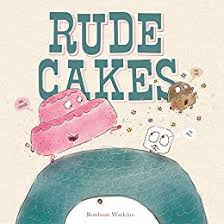
Rude Cakes, Rowboat Watkins
In this sweet book, featuring cakes, giant cyclopses, and good manners, there is lots of humor and wisdom. When the pink, two-layer cake doesn’t say “thank you” for his birthday present, takes a toy that doesn’t belong to him, and ignores his parents’ requests to go to bed (“bedtime is for donut holes”), we know something is about to happen to teach him a lesson.
“I know where it’s going,” said one of my kids when a giant cyclops picks up the rude cake and brings it up to his face. “Rude cake is going to get eaten.” Nope! What happens next will defy your expectations. When it comes to teaching kids that no one “is ever too rude to change,” this book definitely takes the cake.
Best Illustrations

The Cloud Spinner, Michael Catchpool
This book is perfect for budding environmentalists and visual connoisseurs alike. In a magical kingdom lives a wise cloud spinner, who, with the whirl of a wheel, turns clouds into thread, and, with the clickety-clack of a loom, turns the thread into clothes. The only problem is that the more clouds he takes, the less it rains. And the king of the land is just not at all concerned with the environmental havoc he’s bringing down upon his people.
The incredibly unique illustrations appear aged and cracked like medieval frescoes. Something about the use of colors and proportion in the artwork is riveting and invites repeat exploration. It’s a great book to help us think about our choices, respecting natural resources, and taking only what we need. It also offers an easy segue into the science of clouds, water on Earth, and the water cycle.

The Gardener, Sarah Stewart
Sarah Stewarts’ The Gardener is wonderfully written with a heady mix of sentimental and informative. It’s the Great Depression, and Lydia Grace leaves her home in the country to live with an uncle she’s never met before and who never smiles. Her uncle owns a bakery in a big city. Lydia Grace knows a lot about gardening but little about baking. It’s okay; she has a secret—you never really stop being a gardener. David Small’s detailed and delicate artwork is a lot of fun to look at again and again.

Little Red, Bethan Woollvin
This is the story of Red Riding Hood like you’ve never heard it before. You will be smiling and nodding your head while reading about this spunky girl, who can outwit the wolf and save the grandma (no woodcutter’s help required, thank you very much). We love the repeated refrain, “Which might have scared some little girls. But not this little girl.” A bit of dark humor, “Which was unlucky for the wolf.”
The dramatic illustrations are all done in three colors—red, black, and grey. My kids love the unique twist, and this book quickly became everyone’s read-aloud favorite.

Run Wild, David Covell
Run Wild is our new discovery this year, and it’s definitely one of the best-illustrated books we have ever come across. The book’s palpable energy is contagious. The bounce of rhymes, the ebullience of pen-and-ink and watercolor illustrations, and the enthusiasm for life leap at you from the book’s pages, quickening your heartbeat and exciting your spirits. You and your kids will be reaching for your outside shoes the moment you finish reading this book.
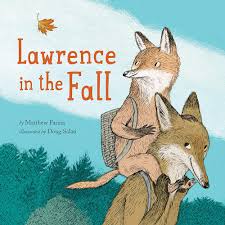
Lawrence in the Fall, Matthew Farina
Lawrence can’t think of anything to collect. His classmates have impressive collections of coins, ribbons, marbles, combs, and playing cards, but Lawrence has nothing. However, a walk in the forest opens Lawrence’s eyes to the natural beauty around him and the unique shape and color of each autumn leaf.
This book will inspire your kids to take a closer look at the stunning shades of red, orange, and yellow in autumn foliage, and maybe even start a leaf collection of their own. I have a soft spot for beautiful pencil artwork, and this book is a treat.

King Bidgood’s in the Bathtub, Audrey Wood
This is the funniest book about bath time you will ever read. The King of all the land is refusing to leave his bathtub, despite the best effort of his Queen, a Duke, and a Knight.
The joyful rhyming text is great to read aloud. I’d read this book about a hundred times to my kids when I learned about a different edition that comes with a CD. The musical CD with six beautiful songs makes the story even more amazing. And did I mention the Caldecott medal illustrations that you will spend hours studying?
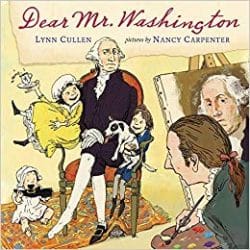
Dear Mr. Washington, Lynn Cullen
When a modern president wants to have his visage preserved for posterity, all he has to do is call in photographers who will snap his picture in an efficient and organized manner. When George Washington needed his picture, he had to visit an artist and pose for hours (actually days!). The talented painter in this story has lots of loud, energetic children (your children will totally recognize themselves in the pages of this story), and each sitting escalates in unbelievable chaos.
This thrilling, hilarious, and lovable true story behind George Washington’s famous portrait by one of America’s most famous portraitists, Gilbert Stuart, is truly amazing. The artwork by the incredible Nancy Carpenter is superb. I can’t recommend this book enough!
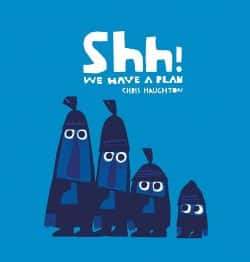
Shh! We Have a Plan, Chris Haughton
This exuberant and strikingly illustrated book appealed to all my children. It centers on the four heroes’ quest to catch a firebird. They have a plan. But things don’t always go according to plan, do they? My kids laughed over the silliness, studied the shades of blue (who knew there were so many), and found a lot of topics for discussion. Should the bird be caught? Should we go with the crowd? Should we learn from our mistakes?

A Big Mooncake for Little, Grace Lin
The stunning full-page spreads pack a powerful visual force, and the story is amazing. Since ancient times people looked at the full moon and came up with theories to explain it. This original modern myth tells a story of a mom who bakes a Mooncake once a month and her daughter who nibbles away on it every night.
My kids love finding hidden meaning in natural events, and this story impressed them very much. My ten-year-old said, “That’s a nifty way to spin it.”

Lentil, Robert McCloskey
Lentil can’t sign or whistle, but he is determined to make music. So he saved up enough pennies to buy himself a harmonica and decided to become an expert. He practiced every chance he got, and when the cornetist, piccolo player, trombone player, and tuba player in the city’s band got a funny case of puckered up lips, Lentil saved the day. “So you never can tell what will happen when you learn to play the harmonica.” The drawings are absolutely fantastic!
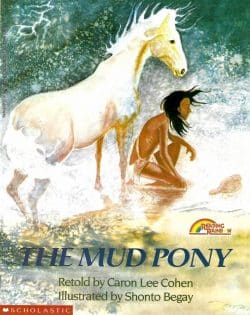
The Mud Pony, Caron Lee Cohen
Kids will walk away from this story with three lessons—love nature, love your family, and we are never alone. Every time I read this ancient story from the Skidi band of the Pawnee Indians of the American Plains, I get goosebumps. When a poor Indian boy made a pony out of mud, he wished for a real pony and magically it came to life. After many adventures, close calls, and a fierce battle with another tribe, the boy on a mud pony is made a chief, and the pony returns to mud with the message, “I am here, your Mother Earth. You are not alone!”
The gorgeous paintings by Native American artist Shonto Begay are a piece of art. Reflecting the mystical spirituality of a legend, dreamy, evocative, soft images fill us with wonder about the striking possibility of greater power than ourselves to guide us in life.
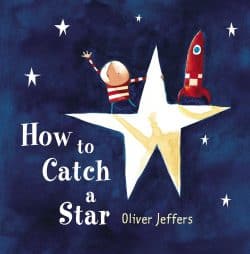
How to Catch A Star, Oliver Jeffers
In this gorgeously illustrated book, a young boy braves climbing the tallest trees, heavy lifting, and a long wait all in the hopes of catching a star. As everyone knows, catching a star is not easily possible, but persistence is usually rewarded—even if not in an expected way. This book would be of great interest to all space lovers.
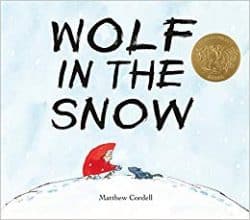
Wolf in the Snow, Matthew Cordell
This 2018 Caldecott Award-winning book is a favorite with all of my children. A snowstorm is happening out in the countryside, and a little girl in a red jacket is lost in the snow. Someone else is lost in the snow—a wolf pup. There are quite a few nail-biting moments, like when the girl comes across a wolf pack, or when she almost freezes in a storm. But at the moment when a little girl, a wolf pup, and a mother wolf all get together on a double spread, we can’t help holding our breath. This exceptional story is told entirely through pen and ink with watercolor illustrations without any words. We each studied the pages of this book hundreds of times, and we can’t get enough of it.

The Princess and the Warrior: A Tale of Two Volcanoes, Duncan Tonatiuh
In this beautiful book, award-winning Mexican-American author and illustrator Duncan Tonatiuh captures the majestic beauty of a little known Aztec creation legend. Forty miles outside of Mexico City, there are two volcanoes, and this story explains in a thoroughly captivating fashion how they came to exist.
Power, betrayal, and love come together in a style that is surprisingly similar to the Romeo and Juliet story (nothing is new under the sky). We love the inclusion of words from the Aztec (Nahuatl) language, the traditional language of the area before the Spanish conquistadors arrived. How cool!
I still haven’t told you about unique illustrations. Most illustrations are two dimensional, trying to reflect the three-dimensional reality of life. In this book, all things are intentionally depicted as flat or 2-D, and all the characters have the same face. But despite the same face, there is no confusion about who is who because each participant in the story is given a distinguishing item of clothing.
Poetry

Goodnight Goon, Michael Rex
The idea of turning kids’ beloved classic Goodnight Moon into a Halloween tale is brilliant. My kids know by heart the words of Goodnight Moon, and it adds a certain level of excitement to reading Goodnight Goon.
“In the cold gray tomb // There was a gravestone // And a black lagoon // And a picture of… // Martians taking over the moon // And there were three little mummies rubbing their tummies…. “
I don’t know about you, but I’m impressed with all the neat and awesome rhyming. Nothing feels forced and out of tune. We like the detailed illustrations by the author. It’s a wonderful addition to your library.

The Bippolo Seed, Dr. Seuss
The Bippolo Seed is little known, but it’s my favorite Dr. Seuss book. In the story, “a young duck named McKluck had a wonderful, wonderful piece of good luck” when he found a seed that he can plant to grow a Bippolo Tree. And “whatever you wish for, whatever it be will sprout and grow out of a Bippolo Tree.” As can be expected, things don’t go as expected, and there are a few valuable lessons to learn along the way. The book features the typically captivating Dr. Seuss rhyme, his deft drawings, and a memorable plot.

A Child’s Garden of Verses, Robert Louis Stevenson
My most favorite book of poetry to read with my kids is A Child’s Garden of Verses by Robert Louis Stevenson. I never tire of reading it with my children and now have memorized many of the poems.

Please Bury Me in the Library, J. Patrick Lewis
This collection is all about books and reading, so if you love books, reading, and good poetry, you will definitely enjoy this book. Here is a sample from one of the poems: “A good book is a kind of a person with a mind of her own” and “a bad book owes to many trees a forest of apologies.” So true!
And another: “What if books had different names like Alice in … Underland? Furious George, Goodnight Noon … ” This poem got us thinking and amusing ourselves with wordplay and alternatives titles — Charlotte’s Dead, A Wrinkle in Slime, The Little Engine that Stood, Where the Wild Things “Arrrgh!” Ha-ha-ha!
We love J. Patrick Lewis for making us think about something we haven’t thought about before. Heaven as a library? Reading books to eternity? Brilliant! “Please bury me in the library in the clean, well-lighted stacks of novels, history, poetry, right next to the paperbacks.”
Lively illustrations add to the reading enjoyment.

Rain Makes Applesauce, Julian Scheer
Rain Makes Applesauce (Caldecott Medal Finalist) is an imaginative and playful tale open to many interpretations. Its lilting poetry encourages creativity, and my kids come up with a different meaning every time we read it. Detailed and beautiful drawings remain interesting no matter how many times we look at them.

Madeline, Ludwig Bemelmans
“In an old house in Paris
That was covered in vines
Lived twelve little girls
In two straight lines.”
Thus begins the unforgettable story of a little girl named Madeline who lives in a French boarding house sometime after World War I. Richly satisfying and evocative, this is one of the books that cause all my kids to gather over it the moment it comes out. There is something about Ludwig Bemelmans rhyming and Madeline’s lovable personality that makes it addictive (in a good way). It has a bit of everything: an exploration of Paris from a child’s perspective, a bit of drama that involves an ambulance ride, and Caldecott Honor illustrations.

The Rain Train, Elena De Roo
“When the rain fingers drum out a dance on the pane,
When the windows are foggy enough for my name,
A pitter-pat-pat, a pitter-pat-pat,
A pittery-pittery-pittery-pat.”
Are you tapping out the pattern with your fingers yet? This book is so much fun to read aloud, and it combines two of my kids’ favorite things—storms and trains. When the rainstorm comes to kids in this story, they board a train that takes them “over the bridge – Whooshety-wish, Racing the moon – Swishety-swish.” All the kids on the train go to sleep to the pitter-pat of rain as the train races ahead.
The rhyme and rhythm of the story is extremely enjoyable, and the use of onomatopoeia is brilliant. Not only that, but the illustrations are great, too. You won’t grow tired of rereading this book.
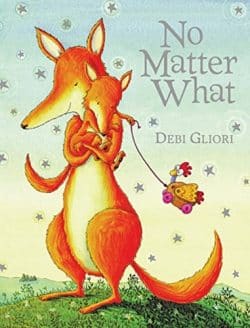
No Matter What, Debi Gliori
If you haven’t yet read this heartwarming book to your kids, then run to the library and get a copy right away. In this story, a fox child wants the reassurance of his mother’s unconditional love, and he learns that his mother will always love him no matter what. The sweet rhyming text and warm illustrations will probably bring up very strong emotions in you. Sniffing and outright weeping is acceptable.
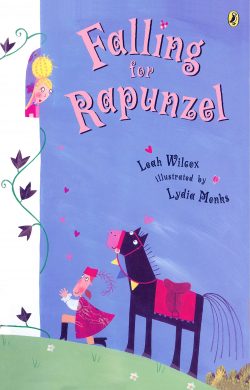
Falling for Rapunzel, Leah Wilcox
I wish I could read it for the first time again. The first time is always the funniest. In this version, Rapunzel sits at the top of the tower and has a hard time hearing what the Prince is saying down below. “Rapunzel, Rapunzel, let down your hair,” he pleads. Instead, she throws down her underwear. “No, Rapunzel, your curly locks.” Of course, she throws down her dirty socks. The blushing hero is growing more agitated by the minute and pleads for a braid; Rapunzel pushes out her maid. Watching her maid ride into the sunset with a prince, Rapunzel says, “I’m glad I finally heard him right.” And then she comes out of the tower door and wonders why the maid and the princess couldn’t just use the door. He-he!
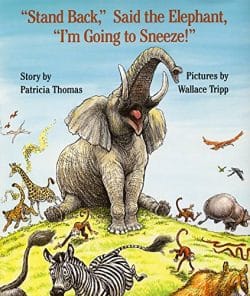
“Stand Back,” Said the Elephant, “I’m Going to Sneeze!”, Patricia Thomas
This is a hilarious, rhyming story about an elephant that is about to sneeze. A buffalo, monkeys, a parrot, bees, a bear, and other animals are worried that the elephant’s sneeze will cause them harm.
“You make such a breeze when you sneeze. // The last time you blew us right out of the trees. // The branches began to bend and to sway // And some of us landed so far away // We didn’t get back until the next day.”
Little did they know that it’s not a sneeze but the elephant’s joy at not sneezing that will cause all the trouble.
What’s on your list of great children’s books?


Great list Eva!
The most crucial element of a children’s story is not its plot nor its characters, it is its ability to leave a lasting impact on the hearts of its young audience.
You may also check the blog about Heartwarming Memoirs for Kids
Hope this will also help. Thank you.